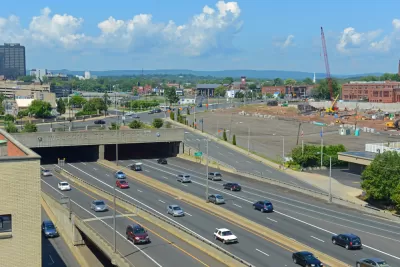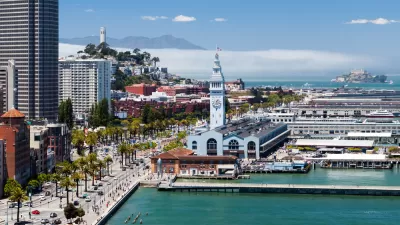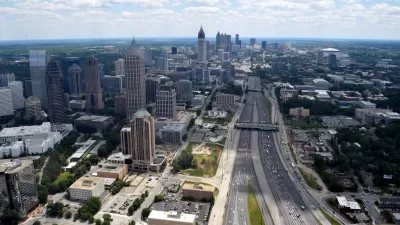A new plan would spend an estimated $17 billion to remove a huge chunk of the Interstate Highway System's footprint in Hartford, Connecticut.

Tom Condon reports on an ambitious new plan to recover some of what was lost when interstate freeways were built through the city six decades ago.
First, the historical context:
Decades ago, the construction of I-91 cut Hartford off from the Connecticut River. I-84 isolated the North End from downtown and consumed a large swath of land and many historic buildings, including the majestic Hartford Public High School campus. The interchange of the two highways laid waste to part of the central business district.
East Hartford wasn’t spared; its massive “mixmaster” interchange occupies an area the size of downtown Hartford.
Two plans have attempted to rectify the damage from these decisions in the past decade, according to Condon, but neither made much progress. But a new plan, emerging as a hybrid of the previous ideas, has emerged.
"The new plan is part of a regional planning effort called Hartford 400, initiated by the iQuilt project in Hartford. It envisions a roughly triangular ring road around the downtown, with some tunneling but much less than Larson proposed, and new connections to East Hartford," according to Condon. The project would cost an estimated $17 billion, but the results would include removing the I-84/I-91 and "mixmaster" interchanges, freeing up more than 150 acres of "prime urban land" for development. In addition, the plan would also cap I-91 through downtown Hartford.
The article includes more details about the iQuilt Partnership, the brainchild of Hartford native and Los Angeles-based urban planner, Doug Suisman.
FULL STORY: There’s a new plan for realigning Hartford’s highways. Is the third time the charm?

Planetizen Federal Action Tracker
A weekly monitor of how Trump’s orders and actions are impacting planners and planning in America.

Maui's Vacation Rental Debate Turns Ugly
Verbal attacks, misinformation campaigns and fistfights plague a high-stakes debate to convert thousands of vacation rentals into long-term housing.

San Francisco Suspends Traffic Calming Amidst Record Deaths
Citing “a challenging fiscal landscape,” the city will cease the program on the heels of 42 traffic deaths, including 24 pedestrians.

Defunct Pittsburgh Power Plant to Become Residential Tower
A decommissioned steam heat plant will be redeveloped into almost 100 affordable housing units.

Trump Prompts Restructuring of Transportation Research Board in “Unprecedented Overreach”
The TRB has eliminated more than half of its committees including those focused on climate, equity, and cities.

Amtrak Rolls Out New Orleans to Alabama “Mardi Gras” Train
The new service will operate morning and evening departures between Mobile and New Orleans.
Urban Design for Planners 1: Software Tools
This six-course series explores essential urban design concepts using open source software and equips planners with the tools they need to participate fully in the urban design process.
Planning for Universal Design
Learn the tools for implementing Universal Design in planning regulations.
Heyer Gruel & Associates PA
JM Goldson LLC
Custer County Colorado
City of Camden Redevelopment Agency
City of Astoria
Transportation Research & Education Center (TREC) at Portland State University
Jefferson Parish Government
Camden Redevelopment Agency
City of Claremont





























